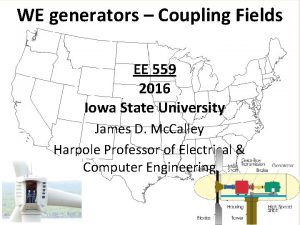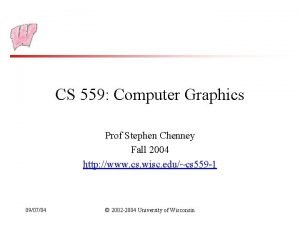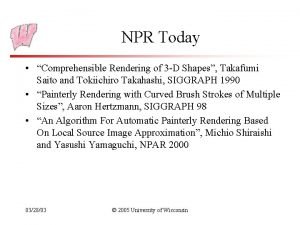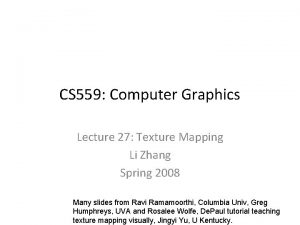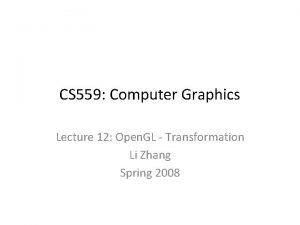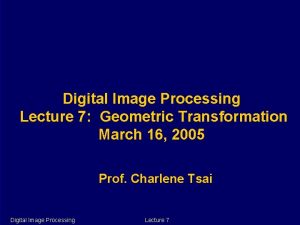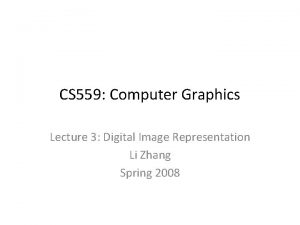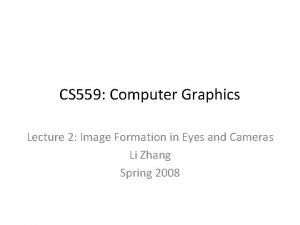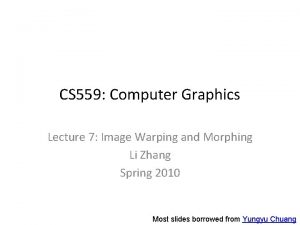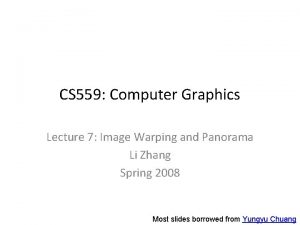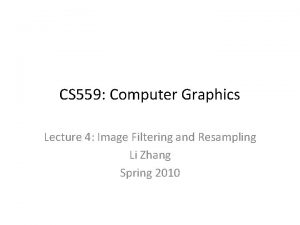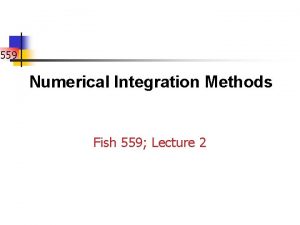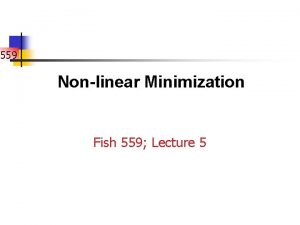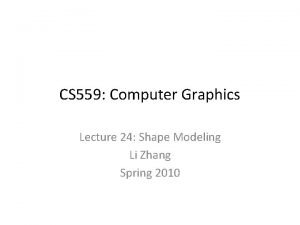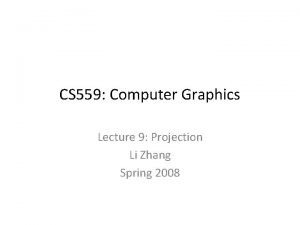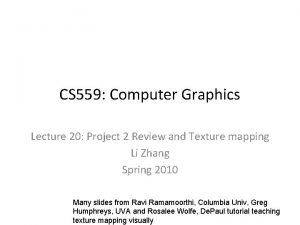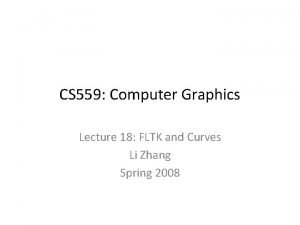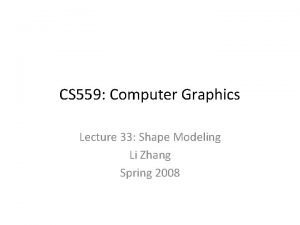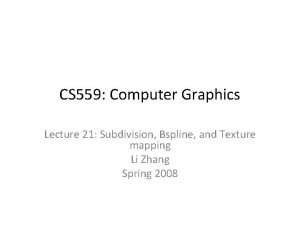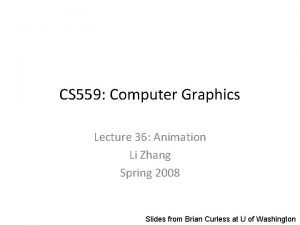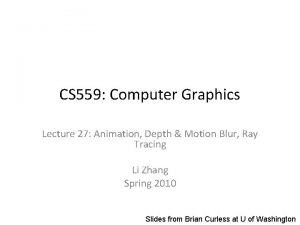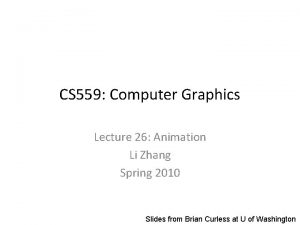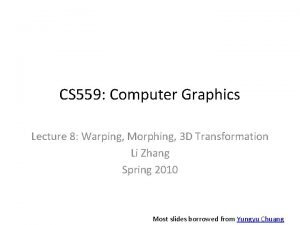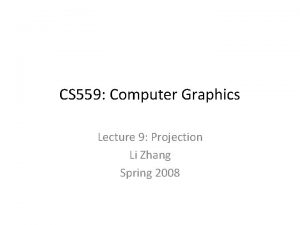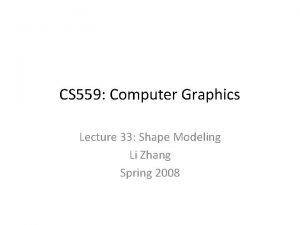CS 559 Computer Graphics Lecture 3 Digital Image






































- Slides: 38

CS 559: Computer Graphics Lecture 3: Digital Image Representation Li Zhang Spring 2008

Image Representation • Images – Something that represents a pattern of light that will be perceived by something • Computer representation – Sampled From http: //www. unl. edu/dpilson/sunflower. html

Image Representation • Images – Something that represents a pattern of light that will be perceived by something • Computer representation – Sampled – Object based Sampled from James O’Brien

Image Representation • Images – Something that represents a pattern of light that will be perceived by something • Computer representation – Sampled – Object based Sampled PS Type one font from James O’Brien

Image Representation • Images – Something that represents a pattern of light that will be perceived by something • Computer representation – Sampled – Object based – Functional f(z) = z*z+c where z is a complex number Set of c such that {f(0), f(f(f(0)), …} is bounded Mandelbrot Fractal Plot by Vincent Stahl http: //upload. wikimedia. org/wikipedia/en/c/ce/Mandelbrot_zoom. gif

Image Representation • Images – Something that represents a pattern of light that will be perceived by something • Computer representation – Sampled – Object based – Functional

Image Representation • Images – Something that represents a pattern of light that will be perceived by something • Computer representation – Sampled – Object based – Functional

Image Representation • Images – Something that represents a pattern of light that will be perceived by something • Computer representation – Sampled – Object based – Functional L-system tree http: //gamedev. cs. cmu. edu/graphics 1/lab 4. php

Image as a discreet function Represented by a matrix: Q 1: How many discrete samples are needed to represent the original continuous function? Q 2: How to reconstruct the continuous function from the samples?

Sampling a continuous function (1 D) Continuous Function Discrete Samples Sampling Period T = 32 Sampling Period T = 16 Sampling Period T = 8 Sampling Period T = 4 The denser the better, but what’s the minimum requirement?

Consider a simple case – sine wave 40 samples period 4 samples period 8 samples period 2 samples period Intuitively, each period should have at least 2 samples to represent the up-and-down shape of sine wave. 1 samples period Theoretically, it can be proved that if we have more than 2 samples period, we can recover the sine wave from the samples.

How about general functions? • Idea: represent an arbitrary function using sine waves.

Fourier Series • Any periodic function f(x) can be expressed by summing up a sequence of sine and cosine waves. For example -2 -1 0 1 2 Sum of the first 1 term Sum of the first 4 terms Sum of the first 12 terms Sum of the first 25 terms If we approximate the function by a finite number of sine terms, we can sample this function at a sampling frequency that is twice its highest sine wave frequency.

Fourier Transform • In general, a non periodic function f(x) can be represented as a sum of sin’s and cos’s, using all frequencies. For example, -2 1 -1 0 1 2 2 1 3 4 2 3 4

Fourier Transform • In general, a non periodic function f(x) can be represented as a sum of sin’s and cos’s, using all frequencies. F(s) is the Fourier Transform of f(x)

Another example of Fourier Transform -s s -1/s The Fourier Transform of a Gauss is still a Gauss

Sampling theorem • This result is known as the Sampling Theorem and is due to Claude Shannon who first discovered it in 1949: A signal can be reconstructed from its samples without loss of information, if the original signal has no frequencies above ½ the sampling frequency.

Reconstruction theorem -3 T -2 T -T T 2 T 3 T -4 -3 -2 -1 0 1 2 3 4

Reconstruction theorem

Reconstruction filters • The sinc filter, while “ideal”, has two drawbacks: – It has large support (slow to compute) – It introduces ringing in practice • We can choose from many other filters…

Cubic filters • Mitchell and Netravali (1988) experimented with cubic filters, reducing them all to the following form: • The choice of B or C trades off between being too blurry or having too much ringing. B=C=1/3 was their “visually best” choice. • The resulting reconstruction filter is often called the “Mitchell filter. ”

Practical upsampling • When resampling a function (e. g. , when resizing an image), you do not need to reconstruct the complete continuous function. • For zooming in on a function, you need only use a reconstruction filter and evaluate as needed for each new sample. • Here’s an example using a cubic filter:

Practical upsampling • This can also be viewed as: 1. putting the reconstruction filter at the desired location 2. evaluating at the original sample positions 3. taking products with the sample values themselves 4. summing it up

2 D Fourier transform Spatial domain Frequency domain

Reconstruction filters in 2 D • We can also perform reconstruction in 2 D…

2 D resampling We’ve been looking at separable filters: How might you use this fact for efficient resampling in 2 D?

Image Downsampling 1/8 1/4 Throw away every other row and column to create a 1/2 size image - called image sub-sampling

Image sub-sampling 1/2 Why does this look so crufty? 1/4 (2 x zoom) 1/8 (4 x zoom)

Practical downsampling • Downsampling is similar, but filter has larger support and smaller amplitude. • Operationally: 1. Choose reconstruction filter 2. Compute the downsampling rate, d, ratio of new sampling rate to old sampling rate 3. Stretch the filter by 1/d and scale it down by d 4. Follow upsampling procedure (previous slides) to compute new values

Subsampling with Gaussian pre-filtering Gaussian 1/2 G 1/4 G 1/8 • Solution: filter the image, then subsample

Compare with. . . 1/2 1/4 (2 x zoom) 1/8 (4 x zoom)

Explanation using Fourier Transform

Explanation using Fourier Transform

2 D convolution theorem example |F(sx, sy)| f(x, y) * h(x, y) g(x, y) |H(sx, sy)| |G(sx, sy)|

2 D Fourier examples Spatial domain Frequency domain

Convolution theorems • Convolution theorem: Convolution in the spatial domain is equivalent to multiplication in the frequency domain. • Symmetric theorem: Convolution in the frequency domain is equivalent to multiplication in the spatial domain.

Convolution Example Result Filter Function http: //www. cs. brown. edu/exploratories/free. Software/repository/edu/brown/cs/exploratories/ap plets/special. Function. Convolution/special_function_convolution_java_browser. html 9/23/04 © University of Wisconsin, CS 559 Spring 2004

Convolution properties • Convolution exhibits a number of basic, but important properties…easily proved in the Fourier domain. Commutativity: • Associativity: • Linearity: •
 Computer graphics
Computer graphics Dot matrix display ppt
Dot matrix display ppt Ee 559
Ee 559 Cs 559
Cs 559 Cs 559 uw madison
Cs 559 uw madison 559 redbook
559 redbook Cs 559
Cs 559 Image transform in digital image processing
Image transform in digital image processing Optimum notch filter in digital image processing
Optimum notch filter in digital image processing Fundamentals of image compression
Fundamentals of image compression Key stage in digital image processing
Key stage in digital image processing Analog image and digital image
Analog image and digital image Variable length coding in digital image processing
Variable length coding in digital image processing Image sharpening in digital image processing
Image sharpening in digital image processing Geometric transformation in digital image processing
Geometric transformation in digital image processing Zooming and shrinking of digital images
Zooming and shrinking of digital images Walsh transform in digital image processing
Walsh transform in digital image processing Image geometry in digital image processing
Image geometry in digital image processing Noise
Noise 01:640:244 lecture notes - lecture 15: plat, idah, farad
01:640:244 lecture notes - lecture 15: plat, idah, farad Image processing lecture notes
Image processing lecture notes Euclidean transformation in digital image processing
Euclidean transformation in digital image processing Digital graphics and animation
Digital graphics and animation The purpose of digital graphics
The purpose of digital graphics Investigating digital graphics
Investigating digital graphics Computer security 161 cryptocurrency lecture
Computer security 161 cryptocurrency lecture Computer aided drug design lecture notes
Computer aided drug design lecture notes Computer architecture notes
Computer architecture notes Isa computer architecture
Isa computer architecture Crt in computer graphics
Crt in computer graphics Projection types in computer graphics
Projection types in computer graphics Types of display devices in computer graphics
Types of display devices in computer graphics Interior and exterior clipping in computer graphics
Interior and exterior clipping in computer graphics Shear transformation in computer graphics
Shear transformation in computer graphics Glsl asin
Glsl asin Scan converting circle in computer graphics
Scan converting circle in computer graphics Center of mass of a rigid body
Center of mass of a rigid body Seed fill algorithm in computer graphics
Seed fill algorithm in computer graphics Starburst method in computer graphics
Starburst method in computer graphics


